What was Pangea like?
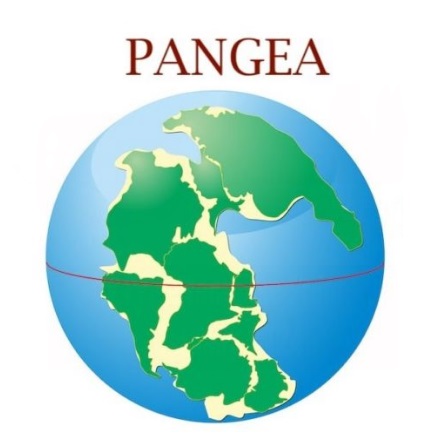
What was Pangea like?
Approximately 200 million years ago, the continents did not have the current configuration, there was only a continuous continental mass called pangea . … This continuous continental mass was called Pangea , from the Greek “all the Earth”, and was surrounded by a single Ocean, called Panthalassa.
Pangea: definition and theory
The six continents present on planet Earth along with their oceans are the result of millions of years of geographical evolution. The distribution of current continental masses has arisen from the fragmentation of a previous supercontinent called “Pangea”, which would have existed approximately 300 and 200 million years ago.
Surely you already knew or had heard about the existence of Pangea, but… Do you know how it was formed and fragmented? Do you know the theory of continental drift? Keep reading this article and summary from EcologíaVerde and learn a little more about Pangea, its definition and theory .
What is Pangea and its characteristics
Pangea is the name of a supercontinent that existed on planet Earth between the end of the Paleozoic era and the beginning of the Mesozoic era, approximately 300 million years ago , and which would have existed for another 160 million years.
This large continental mass was named by the German meteorologist and geophysicist Alfred Wegener, who is also the author of the theory of continental drift. Below we tell you about some of the features of Pangea :
- It is the most recent supercontinent to have existed and the first to be reconstructed by geologists.
- Pangea means “the whole earth” : it is believed to have had a “U” or “C” shape distributed across the equator with the majority of the territory over the southern hemisphere.
- It is believed that the size of Pangea was relatively small : so terrestrial animals would have been able to migrate from one end to the other.
- The innermost regions of the continental mass would have been very dry : due to the lack of precipitation.
- The supercontinent Pangea would have been surrounded by a single superocean : we are talking about Panthalassa.
- During the existence of Pangea, numerous species of plants and animals would have emerged : both marine and terrestrial, including Traversodontidae (a family of herbivores).
- Approximately 250 million years ago, a Permian-Triassic mass extinction occurred : more than 90% of marine species and 70% of terrestrial species disappeared. Also affecting a large number of insects.
Now that you know what Pangea is and what its most notable characteristics are, let’s see how Pangea was formed.
How Pangea formed
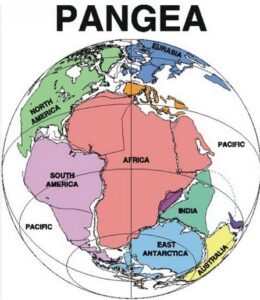
The formation and separation of the supercontinent Pangea is a somewhat cyclical phenomenon that has been repeated throughout the history of the Earth. In fact, it is believed that before Pangea there existed the supercontinent Pannotia, and even further back in time, Rodinia.
Approximately 500 million years ago Pannotia fragmented into two : Gondwana to the south and Proto-Laurasia to the north. Both became distant and the second of them, the smallest, broke up, giving rise to three fragments: Laurentia, Siberia and Baltica, with Baltica to the east of Laurentia and Siberia to the northeast.
This was followed by numerous steps of displacements, collisions, unions and fragmentations of the different continental masses.
Until finally they would have adopted a distribution in which most of the continental masses were united forming a single “C”-shaped supercontinent and an ocean within it, the Tethys. This would be the large land mass that Wegener called Pangea.
Why did Pangea break up?
We already know how Pangea was formed, now let’s see how it broke apart and why it no longer exists. The fragmentation of the supercontinent would have begun between the end of the Triassic and the beginning of the Jurassic (approximately 200 million years ago) and was due to the same reasons why it was formed: changes and movements of the tectonic plates .
The fragmentation process would have first produced two continents: Gondwana to the west and Laurasia to the north, separated by the Thesis Sea. A series of fragmentations and displacements would have formed the continents we know today.
In fact, Australia is currently still on a collision course with East Asia and India continues to move north into the continent. So we could say that the breakup of Pangea continues in process .
Theory of continental drift
Alfred Wegener was the author of the theory of continental drift, which refers to the slow and continuous movement of continental masses .
It all began when in 1910, Wegener began to notice that the silhouettes of the current continents fit together. Added to a series of empirical-rational observations, they would lead Alfred to unite the continents and form a supercontinent that he would call Pangea.
At first, this hypothesis was rejected by the scientific community, since Wegener was unable to explain what would have driven the supposed movement of the land masses.
The meteorologist died and, 30 years later, the theory of plate tectonics would emerge , where the movement of the continents would be explained. It is then that the theory proposed by Wegener is taken as valid and is included within the theory of plate tectonics.
Alfred would have gathered a series of convincing evidence that demonstrated that the continents would have been united and that they were in continuous movement. Some of them were:
- Biological evidence : it was based on the relationship between the species that were distributed on the different continents.
- Paleontological evidence : based on different fossils of the same species that were found on continents separated by oceans. Furthermore, these were organisms such as reptiles or plants that would be incapable of swimming across the large body of water. For example, the mesosaur present in both Brazil and South Africa.
- Geological evidence : justified by the similar geological formations between different continents. For example, it suggested that the Cape Fold Belt, the mountain belt of South Africa, would have been linked to the Sierra de la Ventana in Argentina.
- Geographic evidence : the great coincidence between the coasts of the different continents, especially between South America and Africa, was used as evidence that they would have been united in the distant past.
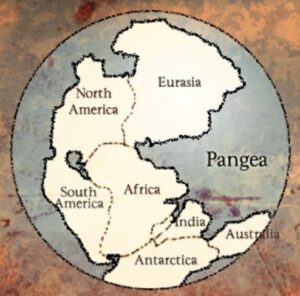
How was Pangea formed?
Given the mechanics of plate tectonics and Earth’s motions, it’s not hard to imagine that during the Paleozoic and Mesozoic eras, our planet didn’t look exactly like we know it today, but what did it look like then? You’ve probably heard of Pangea , right? How much do you know about it? Do you know how the supercontinent Pangea was formed ? Join me to find out these and other details about Pangea.
Pangea, the supercontinent of prehistory
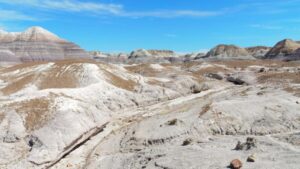
Pangea was the ancestor of all the continents we know today and existed during the geological periods of the end of the Paleozoic era and the beginning of the Mesozoic era , when the Earth was absolutely different from today. When we talk about Pangea we are talking about an enormous continental mass, which was the only continent on the surface of the planet, hundreds of millions of years ago.
In essence, all the continents were connected and thinking about the continents as we do today, by then, a small step would be enough to cross from America to Africa, can you imagine? However, the constant changes above and below the surface were taking apart that huge land mass as if it were a puzzle.
Of course, they teach us all this in school, so there is not much more to say that Pangea was formed more or less 300 million years ago during the Permian period, beginning to fragment in the Triassic and Jurassic periods giving rise to two continents: Gondwana and Laurasia, which finally mutated until they made up all the continental formations we have today.
The formation of Pangea
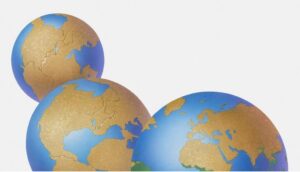
Now, but how did this enormous geological process develop? Well, the answer is very simple: in exactly the same way in which the continents were formed, that is, through the same process and after the same mechanisms that dismantled the supercontinent itself.
Volcanoes, earthquakes, movements in the tectonic plates inside the Earth and various other climatic, oceanic and geological factors moved different parts of the supercontinent until it ended up cracking. The forces that pulled on these fissures ended up cracking Pangea and separating the continent into several parts.
More than 600 million years before these changes, the same factors had united it. I recommend you take a look at the following video, hundreds of millions of years and tectonic movements summarized in less than 2 minutes…
What would Pangea be like today?
How was the land divided?
He would have been one of the two sons of Eber, brother of Joktan and father of Reú. According to Genesis 10:25, it was during the time of Peleg that “the earth was divided “, referring to the land that had its continents still united (Pangea) a short time ago according to the model of geologist Dr.
What will the continents be like in the future?
The supercontinents. Supercontinents form when continents come together: a process that happens in cycles lasting several hundred million years. The current continents of planet Earth are on a collision course to form a new supercontinent in the distant future , around 250 million years.
How many centimeters do the continents move apart per year?
The tectonic plates, which form the surface of the Earth and on which the continents and oceans are located, move an average of 10 centimeters per year . “To give you an idea, it’s the same speed at which our nails grow,” says geologist Felipe Antonio Toledo, from the USP Oceanographic Institute.
What happens to continents when tectonic plates move apart?
What makes the continents move?
The continents move due to the presence of convection cells in the Earth’s mantle.
What are the 7 continents on Earth?
For this reason, the continents of the Earth are : America, Europe, Asia, Africa, Oceania and Antarctica.
What are the names of the continents?
Which countries are mainland?
The world’s continents are large strips of land surrounded by water, where it is possible to find different forms of life, vegetation and climate. In total, there are six: America, Europe, Asia, Africa, Oceania and Antarctica.
What are the continents of the world?
The millimetric movement of these blocks of land gave rise to the current continents . Planet Earth is considered to have six continents : America, Africa, Asia, Europe, Oceania and Antarctica.
What is the continent with the largest number of countries?
What are the most populated continents in the world?
Asia
What continents are part of the Old World?
The Old World is an expression used to designate the worldview that Europeans held around the 15th century. At that time, Europeans only knew the continents of Europe, Africa and Asia. New World is a term created by Europeans to designate the American continent .
Which two countries stand out in Oceania?
Regions of Oceania
- 1) Australasia. It covers the territories of countries such as Australia, New Zealand and New Guinea, which are the largest islands, and also islands in regions close to Indonesia.
- 2) Melanesia. …
- 3) Micronesia. …
- 4) Polynesia. …
- 1) Australia. …
- 2) New Zealand. …
- 3) Papua New Guinea
Which country on the continent known as the New World?
American continent
What are the natural boundaries between Europe and Asia?
Ural Mountains. Extensive mountain range located in Russia, with about 2.
What are the natural boundaries between Europe?
Europe is physically linked with the Asian continent. … The continent in question has a territorial limit with the Glacial Ocean, to the north; with the Mediterranean, Black and Marmara seas and the Caucasus chain, to the south; with the Atlantic Ocean, to the west; and with the Ural Mountains, Ural River and the Caspian Sea to the east.
What separates Europe and Asia?
Comprising the western peninsula of Eurasia, Europe is generally divided from Asia to the east by the watershed of the Ural Mountains, the Ural River, the Caspian Sea, the Caucasus, and the Black Sea to the southeast. … Asia is the largest continent on Earth, with 8.6% of the planetary surface (or 29.5% of the emerging land).
What natural boundaries separate Europe from Asia and Africa?
The Strait of Gibraltar is a natural opening that separates the European and African continents .
What is the shortest distance between Asia and America?
The Bering Strait is a maritime space that stretches 85 kilometers and separates two continents: Asia and North America .
What is the name of the ocean that separates America from Asia?
The Atlantic Ocean is the second largest on Earth and is located between three continents — America, Africa and Europe. It is connected to all oceans, contacting the Arctic Glacier to the north, the Antarctic Glacier to the south, the Indian Ocean to the east, and the Pacific to the west.
What is the name of the sea that separates Asia from Africa?
Mediterranean Sea
What is the name of the sea that separates Africa from Europe?
The Strait of Gibraltar is a maritime channel that separates two continents: Africa and Europe . It is located between the south of Spain, in the British territory of Gibraltar and the north of Morocco, in Ceuta.
What was the sharing?
The Scramble for Africa , also known as the Scramble for Africa or the Scramble for Africa, was the proliferation of conflicting European claims to African territory during the period of neo-imperialism, between the 1880s and the First World War in 1914. .
Where is Mount Urals located?
Europe